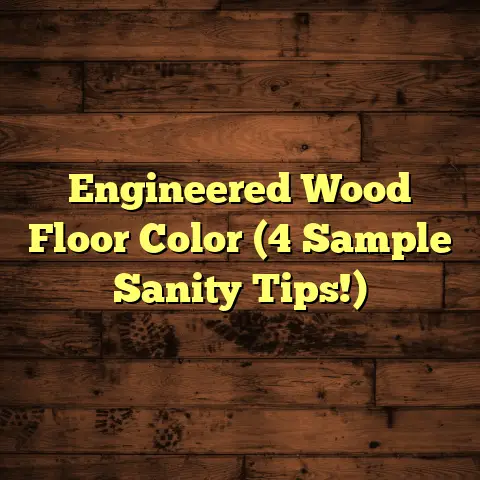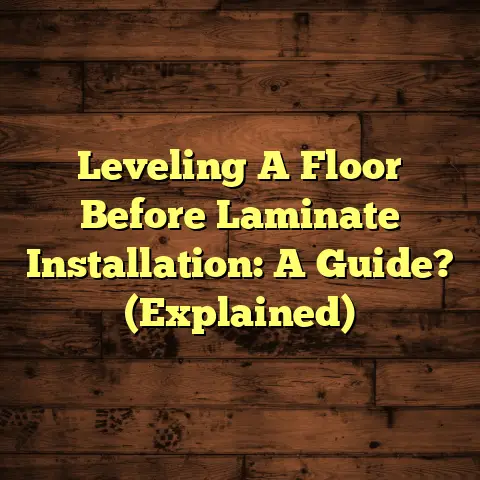How To Stop Termites In Floor? (4 Signs To Act FAST!)
Imagine stepping into your beautifully designed home, where sunlight streams through large windows, illuminating the polished wooden floors that you chose after much deliberation. The scent of fresh coffee wafts through the air, and you feel a sense of peace and satisfaction.
But what if, lurking beneath that beautiful surface, a silent enemy was at work? Termites. These tiny pests can cause major damage to your flooring and compromise the very structure of your home.
That’s why I’m here to give you the lowdown on how to stop termites in your floor. I’ll walk you through four crucial signs that demand immediate action. Trust me, catching this early can save you a ton of money and heartache.
Section 1: Understanding Termites
1.1 What Are Termites?
Okay, let’s get down to basics. Termites are social insects that feed on cellulose, the main component of wood. They’re like tiny, wood-eating machines!
There are three main types you might encounter:
-
Subterranean Termites: These guys live in the soil and build mud tubes to reach wood. They’re the most common and destructive.
-
Drywood Termites: As the name suggests, they live in dry wood and don’t need contact with the soil.
-
Dampwood Termites: These prefer moist, decaying wood. Usually, a sign of a bigger moisture problem.
Think of them as tiny, organized construction crews, but instead of building, they’re demolishing. They thrive in warm, humid environments, and their colonies can grow to enormous sizes.
1.2 Why Termites Target Flooring
Why do these little buggers love our floors so much? Simple: wood!
Wooden floors, especially those made of softwoods like pine, are termite buffets. Plus, the area under your floor is often dark, damp, and undisturbed – the perfect termite playground.
The lifecycle goes something like this:
- Swarmers: Winged termites (alates) fly out to start new colonies.
- Mating: They pair up and find a suitable spot.
- Colony Establishment: They start laying eggs and building their empire.
- Feeding Frenzy: The colony grows, and they start munching on your floor joists, subfloor, and even the flooring itself.
They eat from the inside out, which is why you might not notice them until the damage is severe.
Section 2: The Importance of Early Detection
2.1 The Cost of Termite Damage
Let’s talk numbers. Termite damage isn’t just a cosmetic issue; it can be a serious financial blow.
According to the National Pest Management Association (NPMA), termites cause an estimated $5 billion in property damage annually in the United States. https://www.pestworld.org/pest-facts/termites/
The average cost to repair termite damage can range from a few hundred dollars for minor fixes to tens of thousands of dollars for extensive structural repairs. I’ve seen jobs where we had to completely replace entire sections of flooring and support beams.
Plus, your insurance might not cover termite damage, as it’s often considered preventable maintenance. So, you’re often stuck footing the bill yourself.
Delaying action only makes the problem worse (and more expensive). The longer termites go undetected, the more damage they can cause.
2.2 Consequences of Ignoring Signs
Ignoring the signs of termites can lead to some serious consequences:
-
Structural Issues: Termites can weaken floor joists, support beams, and even walls, making your home unsafe.
-
Floor Collapse: In severe cases, floors can sag or even collapse. I’ve seen it happen, and it’s not pretty.
-
Mold and Mildew: Termite damage can create moisture problems, leading to mold and mildew growth, which can cause health issues.
-
Decreased Home Value: Termite damage can significantly decrease the value of your home.
-
Emotional Toll: Discovering extensive termite damage can be incredibly stressful and emotionally draining. Trust me, I’ve seen homeowners break down in tears.
Section 3: 4 Signs of Termites in Your Floor
Alright, let’s get to the heart of the matter. Here are four signs that termites might be feasting on your floors:
3.1 Sign 1: Hollow Sounding Wood
One of the first signs I always look for is a hollow sound when tapping on the floor.
How to test:
- Grab a rubber mallet or even just your knuckles.
- Gently tap on different areas of your floor, especially near walls, baseboards, and any areas that seem suspect.
- Listen carefully for a hollow or dull sound.
What it indicates:
Termites eat wood from the inside out, leaving behind empty galleries. This creates a hollow space that will sound different from solid wood.
I remember one time, a homeowner called me because her dog kept barking at a specific spot on the floor. When I tapped on it, it sounded like a drum! We pulled up the flooring and found a massive termite colony underneath.
3.2 Sign 2: Mud Tubes on Walls or Floors
Mud tubes are a telltale sign of subterranean termites.
Visual Identification:
- They look like small, earthen tunnels, about the width of a pencil.
- They’re usually brown or grayish-brown.
- You’ll often find them on walls, foundations, or along the floor.
Significance:
Subterranean termites need moisture to survive. They build these tubes to travel from their underground nests to the wood they’re feeding on, protecting themselves from the open air.
Finding mud tubes means that termites are actively foraging for food in your home. It’s like finding a highway system leading straight to your floors!
3.3 Sign 3: Discarded Wings
Have you noticed a bunch of tiny wings lying around your home, especially near windowsills or light fixtures? That’s a red flag.
How to identify:
- Termite wings are small, translucent, and all four wings are the same size and shape. This is different from ants, where the hind wings are smaller.
- They’re usually about ¼ to ½ inch long.
Lifecycle Stage:
These wings are shed by termite swarmers (alates) after they’ve found a mate and are ready to start a new colony.
Finding discarded wings means that termites have likely swarmed inside your home, which significantly increases the chance that they’ve started a colony nearby.
3.4 Sign 4: Visible Damage
This is the most obvious sign, but often the last to be noticed.
Signs of structural damage:
-
Buckling or sagging floors: This indicates that the wood underneath has been weakened.
-
Blistering or peeling paint: Termites can create moisture problems that cause paint to bubble or peel.
-
Small holes in the wood: These might be entry points for termites.
-
Frass: This is termite droppings, which look like tiny, wood-colored pellets.
-
Deterioration and decay: Wood that crumbles easily or looks rotted might be infested.
I once inspected a home where the homeowner had covered up a soft spot in the floor with a rug. When I pulled back the rug, the wood practically disintegrated in my hands!
Section 4: Immediate Actions to Take
Okay, you’ve spotted one or more of these signs. What do you do now? Don’t panic! Here’s a step-by-step guide:
4.1 Assessing the Extent of the Infestation
First, you need to figure out how bad the problem is.
How to conduct a thorough inspection:
- Check all wood surfaces: Pay close attention to floors, walls, baseboards, and window frames.
- Use a screwdriver or awl: Probe any suspicious areas to check for soft or hollow wood.
- Look for mud tubes: Check foundations, walls, and crawl spaces.
- Check for moisture: Termites love damp environments, so look for leaks or areas with poor ventilation.
When to seek professional help vs. DIY solutions:
- Minor Infestation: If you only find a small area of damage and a few termites, you might be able to handle it yourself.
- Serious Infestation: If you see extensive damage, mud tubes, or a large number of termites, call a professional immediately.
4.2 DIY Solutions for Minor Infestations
If you’re dealing with a minor infestation, here are a few DIY options:
-
Borate Wood Preservatives: These are chemicals that are toxic to termites but relatively safe for humans and pets when used properly. You can apply them to exposed wood surfaces.
-
Orange Oil: This natural insecticide can kill termites on contact. Inject it into termite galleries using a syringe.
-
Diatomaceous Earth: This is a non-toxic powder made from fossilized algae. It’s abrasive to termites and will kill them if they crawl through it. Sprinkle it around areas where you’ve seen termite activity.
Step-by-step guide:
- Identify the infested area.
- Remove any damaged wood.
- Clean the area thoroughly.
- Apply the chosen treatment according to the manufacturer’s instructions.
- Monitor the area for continued termite activity.
Important Note: Always wear gloves and eye protection when handling any chemicals. Follow the manufacturer’s instructions carefully.
4.3 When to Call in the Professionals
Sometimes, DIY solutions just aren’t enough. Here are signs that you need to call in the pros:
- Extensive Damage: If you see widespread damage to your floors or other wooden structures.
- Mud Tubes: The presence of mud tubes indicates a large, established colony.
- Large Numbers of Termites: If you’re seeing termites frequently, it’s a sign of a significant infestation.
- You’re Not Comfortable Handling Chemicals: Professional exterminators have access to stronger chemicals and specialized equipment.
What to expect from a professional termite inspection and treatment plan:
- Thorough Inspection: A trained inspector will assess the extent of the infestation and identify the type of termites you’re dealing with.
- Customized Treatment Plan: They’ll develop a plan tailored to your specific situation, which may include soil treatments, baiting systems, or wood treatments.
- Professional Application: They’ll apply the treatments safely and effectively.
- Follow-Up Inspections: They’ll conduct regular inspections to ensure that the termites are gone and to prevent future infestations.
Section 5: Prevention is Key
The best way to deal with termites is to prevent them from ever getting into your home in the first place.
5.1 Long-Term Strategies to Protect Your Floors
Here are some long-term strategies to protect your floors from termites:
- Regular Inspections: Inspect your home regularly for signs of termites, especially around foundations, crawl spaces, and plumbing.
- Reduce Moisture: Fix any leaks, ensure proper drainage, and ventilate crawl spaces to reduce moisture levels.
- Create Barriers: Seal cracks and crevices in your foundation to prevent termites from entering.
- Use Treated Wood: When building or renovating, use pressure-treated wood that is resistant to termites.
5.2 Homeowner Best Practices
Here are some simple lifestyle changes you can make to prevent termite infestations:
-
Store Firewood Away from Your Home: Termites love firewood, so keep it at least 20 feet away from your foundation.
-
Keep Mulch Away from Your Foundation: Mulch can trap moisture and attract termites.
-
Trim Shrubs and Bushes: Overgrown vegetation can provide termites with a bridge to your home.
-
Maintain Your Gutters: Clogged gutters can lead to water damage and attract termites.
-
Proper Ventilation: Ensure proper ventilation in crawl spaces and attics to reduce moisture.
Conclusion: Taking Action Against Termites
Termites can be a homeowner’s worst nightmare, but with knowledge and vigilance, you can protect your floors and your home.
Remember these key takeaways:
- Know the signs: Hollow sounding wood, mud tubes, discarded wings, and visible damage are all red flags.
- Act fast: The sooner you address a termite problem, the less damage they’ll cause.
- Prevention is key: Take steps to reduce moisture, create barriers, and maintain your home to prevent infestations.
Don’t wait until it’s too late. Be proactive, be vigilant, and protect your investment.
Final Thoughts
I hope this guide has been helpful. Remember, your home is your sanctuary, and it’s worth protecting. By understanding the nature of termites, recognizing the warning signs, and implementing effective prevention strategies, you can ensure your beautiful wooden floors remain a source of pride and comfort for years to come.
Good luck, and happy homeownership!





